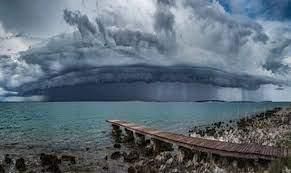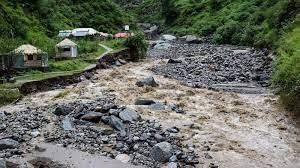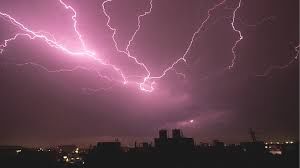Geography - 1 | Current Affairs & Hindu Analysis: Daily, Weekly & Monthly - UPSC PDF Download
| Table of contents |

|
| Massive Shelf Clouds Formation |

|
| Marine Heatwave and its Impacts |

|
| Anthropocene Epoch |

|
| Flash Floods in Himachal Pradesh |

|
| Lightning in India |

|
Massive Shelf Clouds Formation
Recently, a video showcasing a colossal shelf cloud was recorded in Haridwar, Uttarakhand.
What exactly is a Shelf Cloud?
- A shelf cloud is a distinctive low, horizontally shaped arcus cloud, resembling a suspended shelf in the sky.
- This cloud formation is connected to the lower part of the cloud above it, typically associated with a thunderstorm. It is commonly observed along a continuous line of storms. Initially, there is a gust of wind, followed by rainfall.
- The shelf cloud may exhibit a rotational appearance on a horizontal axis. Notably, the advancing (outer) section of the shelf cloud often displays upward cloud movement, while the underside appears turbulent, exhibiting a boiling and wind-torn appearance.
Shelf Cloud Formation:
Shelf clouds form when a mass of cold, dense air is forcefully propelled by the wind into a warmer air mass. This occurs during the downdraft of a thunderstorm, where rapidly descending cold air disperses, creating a robust gust front.
Are They Dangerous?
- Shelf clouds typically do not pose a direct threat, causing tornadoes or extremely hazardous weather on their own.
- They often precede powerful thunderstorms with characteristics such as heavy rain, strong winds, and occasionally hail or tornadoes.
- These clouds usually emerge in conjunction with thunderclouds and downdrafts, signifying the presence of strong wind gusts, heavy rain, or hail.
Arcus Clouds:
- Arcus clouds are striking low-level, elongated clouds associated with potent thunderstorms, sometimes observed beneath Cumulonimbus clouds.
- Two types of Arcus clouds exist: Shelf clouds, attached to the storm cloud, and Roll clouds, horizontal columns separated from the storm cloud.
Arcus Cloud Formation:
- When a cold downdraft from a Cumulonimbus cloud reaches the ground, the cold air may swiftly spread along the ground, displacing existing warm, moist air upward.
- As the air ascends, water vapor condenses, forming the characteristic patterns of Arcus clouds. If the cloud experiences different wind directions above and below, it may roll.
Occurrence:
- Arcus clouds have been observed in various Indian cities during the monsoon months, including Kolkata, Madurai, Mumbai, Chennai, and globally in places like Australia, Alaska, and California during intense thunderstorms.
Additional Definitions:
- Air Mass: A large volume of air in the atmosphere, mostly uniform in temperature and moisture, extending thousands of kilometers in any direction and reaching from ground level to the stratosphere.
- Thunderstorm: A storm producing lightning strikes with a tremendous audible effect in the Earth's atmosphere.
- Tornado: A narrow, violently rotating column of air extending from a thunderstorm to the ground, often visible through a condensation funnel.
- Cumulonimbus: A dense, towering vertical cloud formed from water vapor condensing in the lower troposphere and rising with powerful buoyant air currents.
Marine Heatwave and its Impacts
Since June 28, 2023, the northern Bay of Bengal has been witnessing a severe Marine Heatwave, resulting in unusually heavy rainfall in India's typically dry northwest region.
What is Marine Heatwave?
- Marine Heatwaves refer to extended periods of abnormally high Sea Surface Temperature (SST). These occurrences are associated with detrimental effects on marine ecosystems, including coral bleaching, seagrass destruction, and the loss of kelp forests, posing challenges to the fisheries sector.
- The primary contributors to marine heatwaves are ocean currents, which can accumulate warm water in specific areas, and air-sea heat flux, signifying warming through the ocean surface from the atmosphere.
- Additionally, wind patterns can either intensify or mitigate the warming associated with a marine heatwave, and climate phenomena such as El Niño can influence the likelihood of these events in particular regions.
How Does Marine Heatwave Impact Rainfall in Northwest India?
- The Marine Heatwave in the Bay of Bengal has elevated sea surface temperatures, resulting in increased evaporation rates and a heightened supply of moisture in the atmosphere. This surplus moisture has contributed to above-average rainfall in northwest India.
- The marine heatwave is likely to have influenced the formation and behavior of depressions in the Bay of Bengal, potentially leading to a rise in the frequency and intensity of depressions, particularly on shorter timescales (3-10 days).
- Depressions, being low-pressure systems, play a crucial role in shaping monsoons and rainfall patterns. The marine heatwave, coupled with changes in depression timescales, has affected the trajectory of these weather systems.
- Depressions now tend to move more towards northwest India instead of north-central India, resulting in a higher concentration of rainfall in the northwest region and causing above-average rainfall in that area.
Other Impacts of Marine Heatwaves:
Impact on Ecosystem Structure:
- Marine heatwaves influence ecosystem structure by favoring certain species while suppressing others. They have been associated with the mass mortality of marine invertebrates and may compel species to alter their behavior, putting wildlife at an increased risk of harm.
Changes in Habitat Ranges:
- Marine heatwaves can alter the habitat ranges of specific species, as seen with the spiny sea urchin off southeastern Australia, which has expanded southward into Tasmania, affecting kelp forests it feeds upon.
Economic Consequences:
- Marine heatwaves can lead to economic losses by affecting fisheries and aquaculture.
Biodiversity Effects:
- Biodiversity can be significantly impacted by marine heatwaves. A 2020 study, "Genesis and Trends in Marine Heatwaves Over the Tropical Indian Ocean and Their Interaction With the Indian Summer Monsoon," reveals that a prior marine heatwave led to the bleaching of 85% of corals in the Gulf of Mannar near the Tamil Nadu coast.
Risk of Deoxygenation and Acidification:
- Marine heatwaves often occur concurrently with other stressors like ocean acidification, deoxygenation, and overfishing. In such cases, marine heatwaves not only exacerbate habitat damage but also heighten the risk of deoxygenation and acidification.
Anthropocene Epoch
Recently, geologists announced that sedimentary findings at Crawford Lake in Ontario, Canada, offer evidence marking the commencement of the Anthropocene epoch.
About the Anthropocene Epoch:
- The Anthropocene is a suggested epoch that signifies the current geological time interval characterized by significant changes in the Earth's ecosystem due to human influence.
- Coined and popularized by biologist Eugene Stormer and chemist Paul Crutzen in 2000, the term is derived from the Greek words "anthropo," meaning "man," and "cene," denoting "new."
- Various phenomena are linked to this proposed epoch, including global warming, rising sea levels, ocean acidification, extensive soil erosion, the emergence of lethal heat waves, the degradation of the biosphere, and other adverse environmental alterations.
Geological Time Scale:
- The geological time scale divides Earth's history into hierarchical segments, including eons, eras, periods, epochs, and ages.
- These divisions, based on Earth's rock layers or strata and the fossils found within them, help scientists understand the characteristic organisms of different parts of the geologic record through the study of stratigraphy.
Current Epoch:
- Officially, the current epoch is known as the Holocene, beginning 11,700 years ago after the last major ice age.
Debate:
- Scientists are still debating whether the Anthropocene represents a distinct epoch from the Holocene. The term has not yet been formally adopted by the International Union of Geological Sciences (IUGS), the organization responsible for naming and defining epochs.
- The key question for the IUGS is whether human-induced changes have altered the Earth system to the extent that they are reflected in the rock strata.
Flash Floods in Himachal Pradesh
The 2023 Monsoon season in Himachal Pradesh has triggered severe flash floods in numerous areas, leading to an unprecedented loss of lives and assets.
What are Flash Floods?
Definition:
- Flash floods are sudden rises in water levels, typically occurring during or following an intense period of rainfall. These events are highly localized, of short duration, with a rapid peak, usually having less than six hours between the onset of rainfall and the flood's peak.
Contributing Factors:
- The flood situation aggravates when drainage lines are clogged or encroachments impede the natural water flow. Causes include heavy rain associated with severe thunderstorms, hurricanes, tropical storms, or meltwater from ice or snow over ice sheets or snowfields.
- Flash floods can also result from dam or levee breaks and mudslides (debris flow).
Precipitation Trends in Himachal Pradesh (HP):
- In the Himalayas, there is a noticeable trend of increased precipitation occurring in shorter time spans.
- The Intergovernmental Panel on Climate Change's (IPCC) Sixth Report emphasizes that the Himalayas and coastal regions of India will be severely impacted by climate change.
Meteorological Data:
- According to the India Meteorological Department (IMD), normal rainfall during this period is expected to range between 720mm and 750mm. However, in certain instances, it has surpassed 888mm in 2010 and 926.9mm in 2018.
- The precipitation in HP in 2023 is attributed to the combined impact of the South-West Monsoon and Western Disturbances, with the total rainfall from June to date recorded at 511mm.
What are the Factors of Such Flash Floods in Himachal Pradesh?
Developmental Model Guided by Liberalization:
- Himachal Pradesh's developmental model, fostering progress and ranking second in social development among mountainous regions, has seen the positive outcomes of liberalization through fiscal reforms and self-reliance. However, it has also resulted in increased exploitation of natural resources, leading to ecological impacts.
Hydropower Projects:
- The unregulated construction of hydropower projects has transformed mountain rivers into diminished streams. Water diversion through tunnels and the disposal of excavated material (muck) along riverbeds exacerbate the impact during periods of heavy rainfall or cloudbursts.
- Improper muck disposal not only creates conditions favorable for landslides during the rainy season but also obstructs river valleys with sediments, causing water diversion, overflow, and consequent floods.
Tourism and Road Expansion:
- The expansion of roads driven by tourism has led to the transformation of four-lane and two-lane roads without essential geological studies.
- Vertical cutting of mountains during road construction has resulted in landslides and damage to existing roads even during normal rainfall, escalating destruction during heavy rain or floods.
- Previously, terraced and curved mountain roads, somewhat safer against landslides, have been replaced by more landslide-prone vertical roads.
Cement Plants:
- The establishment of massive cement plants and extensive mountain cutting has altered land use patterns, diminishing the land's water absorption capacity and contributing to flash floods during rainfall.
Changes in Crop Patterns:
- The shift to cash crops and horticulture economies over traditional cereal farming, which require rapid transportation to markets due to their perishable nature, has led to hasty road construction without proper land cutting and drainage.
- This, in turn, results in the rapid swelling of rivers during rainfall, further contributing to floods.
Way Forward
- Institute a Commission of Inquiry involving major stakeholders, empowering local communities over their assets, and insuring assets to facilitate quicker rebuilding. Adequate changes in infrastructure planning are crucial to avert disasters while considering the reality of climate change.
- With climate change as a reality, humans should not add to the problem, but make adequate changes in infrastructure planning to avert disasters that the State has been witnessing for some time.
Lightning in India
Lightning poses a significant threat in India, resulting in a notable number of casualties annually. With states such as Bihar and West Bengal advocating for the classification of lightning as a natural disaster, the Union government has approached the matter cautiously.
- If this proposal gains approval, victims would be eligible for compensation from the State Disaster Response Fund (SDRF), with 75% of the funds contributed by the Central government.
Current Landscape of Lightning in India
Overview:
- Lightning is a striking electrical phenomenon occurring when electrical charges build up within clouds and between clouds and the ground. The discharge of this energy produces a brilliant flash of light accompanied by the characteristic thunder sound.
India's Early Warning System:
- India stands among the top five countries globally with an early warning system for lightning. This system provides forecasts ranging from five days to as close as three hours before lightning events.
Lightning Fatalities: Statistics and Trends
- National Crime Records Bureau (NCRB) Data: In 2021, lightning caused 2,880 deaths, constituting 40% of all accidental deaths attributed to "forces of nature." This indicates a rising trend in lightning-related fatalities compared to other natural events.
Geographical Distribution:
- While the frequency of lightning is highest in northeastern states and regions like West Bengal, Sikkim, Jharkhand, Odisha, and Bihar, central Indian states such as Madhya Pradesh, Maharashtra, Chhattisgarh, and Odisha witness a higher number of lightning-related deaths. Bihar, in particular, faces a significant vulnerability to lightning strikes, recording 107 deaths in 2023 until July 6.
Union Government's Stance:
- The Union government opposes categorizing lightning as a natural disaster, emphasizing that education and awareness initiatives can effectively mitigate lightning-related fatalities.
Factors Behind the Increasing Trend of Lightning Strikes:
- Climate Change: Global warming and climate change may alter atmospheric conditions, potentially leading to increased thunderstorms and lightning activity. Changes in temperature can affect moisture distribution, instability, and convective processes favoring more frequent lightning occurrences.
- Urbanization: The expansion of urban areas contributes to the "urban heat island effect," making cities warmer than surrounding rural areas. This localized warming may induce more thunderstorms and, consequently, an uptick in lightning strikes.
- Land Use Changes: Deforestation, shifts in agricultural practices, and alterations to natural landscapes may disrupt local atmospheric conditions, potentially contributing to the development of thunderstorms and increased lightning.
- Pollution and Aerosols: Air pollution, including aerosols and particulate matter, can influence cloud formation and electrical activity within storms. Anthropogenic emissions may impact the frequency and intensity of thunderstorms, leading to a higher incidence of lightning strikes.
The Way Forward
- Educational Initiatives: Initiate extensive educational campaigns aimed at enhancing awareness about lightning safety. The primary focus should be on educating individuals, especially in rural areas, about the hazards associated with lightning and the precautions they can take to ensure their safety.
- Lightning Prediction and Warning Systems: Develop and implement lightning prediction and warning systems to offer advanced notification of impending lightning storms. This proactive approach enables people to take necessary precautions and seek shelter promptly.
- Lightning-Resistant Infrastructure: Promote the construction of lightning-resistant infrastructure, particularly in high-risk areas such as schools, hospitals, and public buildings. This may involve the installation of lightning rods on tall structures, buildings, and residences, creating a safe path for lightning to travel to the ground and minimizing the risk of damage from a direct strike. Additionally, advocating for the use of surge protectors for electrical equipment and devices is crucial. Surge protectors can redirect excess voltage, safeguarding sensitive electronics from potential damage caused by power surges resulting from lightning strikes.
- Training for First Responders: Provide training to local emergency services and first responders on effectively managing incidents related to lightning. Equipping them with the necessary skills and tools ensures a prompt and efficient response to lightning-related emergencies.
|
63 videos|5408 docs|1146 tests
|
FAQs on Geography - 1 - Current Affairs & Hindu Analysis: Daily, Weekly & Monthly - UPSC
| 1. What causes the formation of massive shelf clouds? |  |
| 2. How does a marine heatwave occur and what are its impacts? |  |
| 3. What is the Anthropocene Epoch and why is it significant? |  |
| 4. What causes flash floods in Himachal Pradesh? |  |
| 5. How common is lightning in India and what are the associated risks? |  |

























